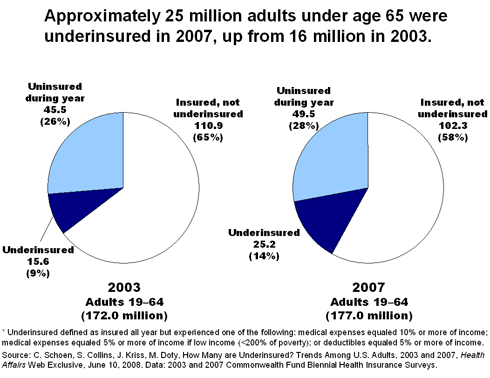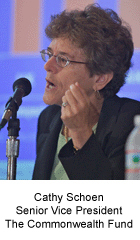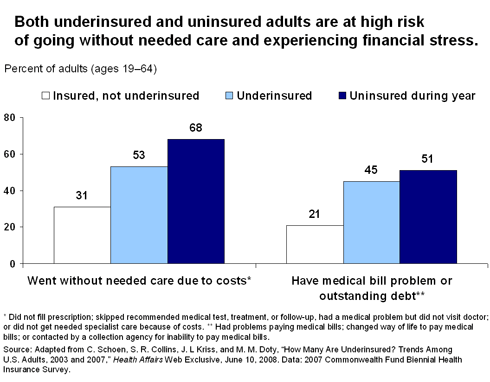The number of underinsured U.S. adults—people who have health coverage but are not adequately protected from high medical expenses—has risen dramatically. A Commonwealth Fund study published by the journal Health Affairs in June finds that as of 2007, there were an estimated 25 million underinsured adults in the U.S., 60 percent more than the 16 million who were underinsured in 2003.
Most of this growth came from rising uninsured rates among middle- and higher-income families, say the authors of How Many Are Underinsured? Trends Among U.S. Adults, 2003 and 2007. While low-income people remain the most likely to be underinsured or uninsured, underinsured rates nearly tripled since 2003 for adults with incomes at or above 200 percent of the federal poverty level (defined as an annual family income of $40,000 or more).

The analysis, which was conducted by the Fund's Cathy Schoen, Sara R. Collins, Jennifer L. Kriss, and Michelle M. Doty, was based on data from the Commonwealth Fund 2007 Biennial Health Insurance Survey. Following the method used in the 2003 baseline study, adults ages 19 to 64 were classified as underinsured if they were insured all year yet spent 10 percent or more of their income (or 5 percent if low-income) on out-of-pocket medical expenses, or if they had per-person deductibles that equaled 5 percent or more of their income. An estimated 14 percent of all nonelderly adults were underinsured in 2007, and more than one of four were uninsured for all or part of the year. Adding these two groups together, 75 million adults—42 percent of the under-65 population—had either no insurance or inadequate insurance in 2007, up from 35 percent in 2003.

Despite having coverage all year, underinsured adults who were surveyed reported experiencing access problems and financial stress at rates similar to those of the uninsured. For example, about half of both the underinsured (45%) and uninsured (51%) adults had difficulty paying medical care bills, were contacted by collection agencies for unpaid bills, or changed their way of life to pay medical bills. By contrast only 21 percent of adequately insured adults reported financial stress related to medical bills.

The sharp increase in the number of underinsured adults, say the authors, is partly due to design changes in insurance benefits that leave individuals financially vulnerable. Underinsured adults were more likely than those with adequate insurance to report benefit limits, such as restrictions on the total amount a plan pays for care or on the number of physicians' visits it allows. They were also far more likely to report high deductibles: one-quarter had annual per-person deductibles of $1,000 or more. Despite benefit limits and higher deductibles, underinsured adults often reported high annual premium costs, in line with those reported by more adequately insured people.